中考英语语法专题讲解——代词(共26张PPT)
文档属性
| 名称 | 中考英语语法专题讲解——代词(共26张PPT) | 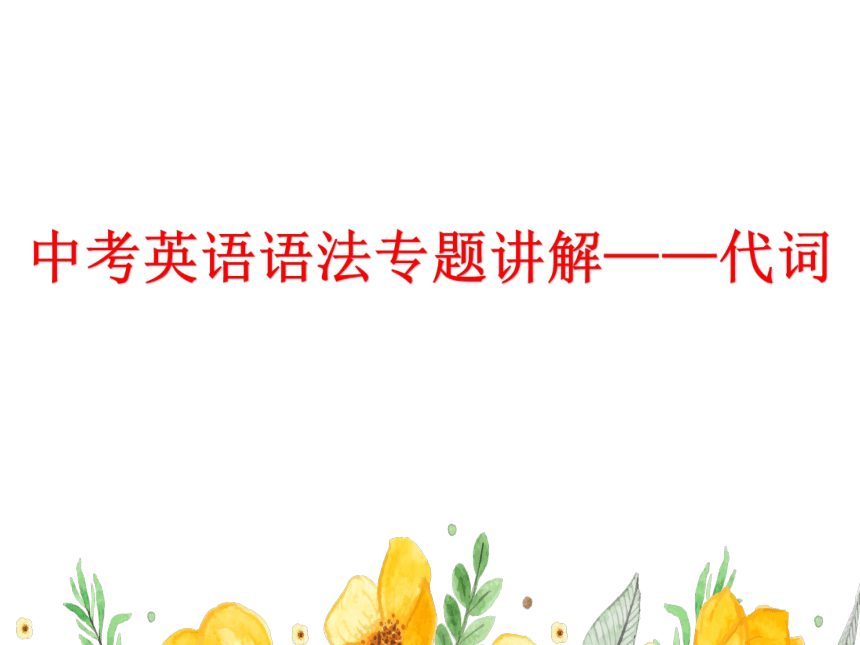 | |
| 格式 | ppt | ||
| 文件大小 | 2.8MB | ||
| 资源类型 | 试卷 | ||
| 版本资源 | 通用版 | ||
| 科目 | 英语 | ||
| 更新时间 | 2022-04-10 21:55:19 | ||
图片预览

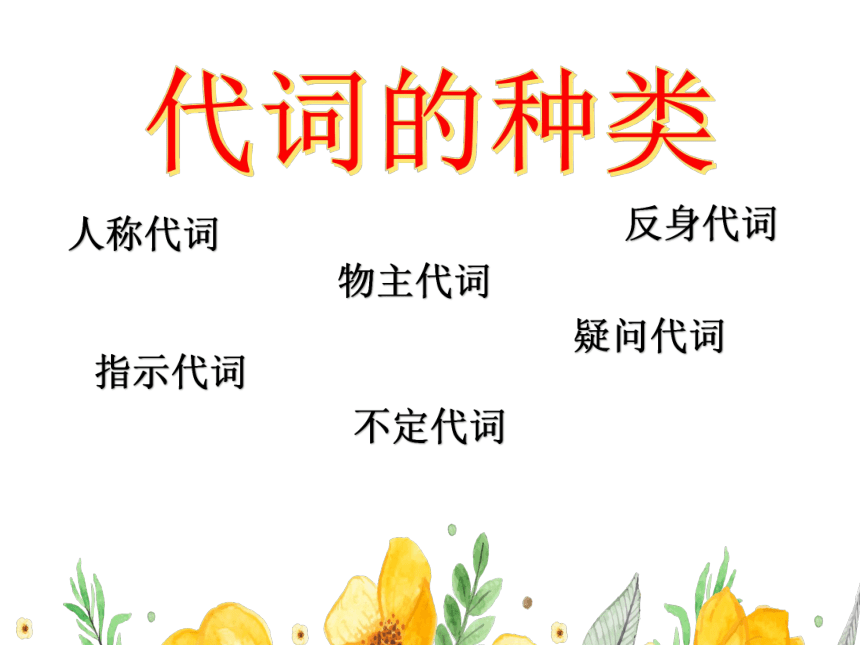
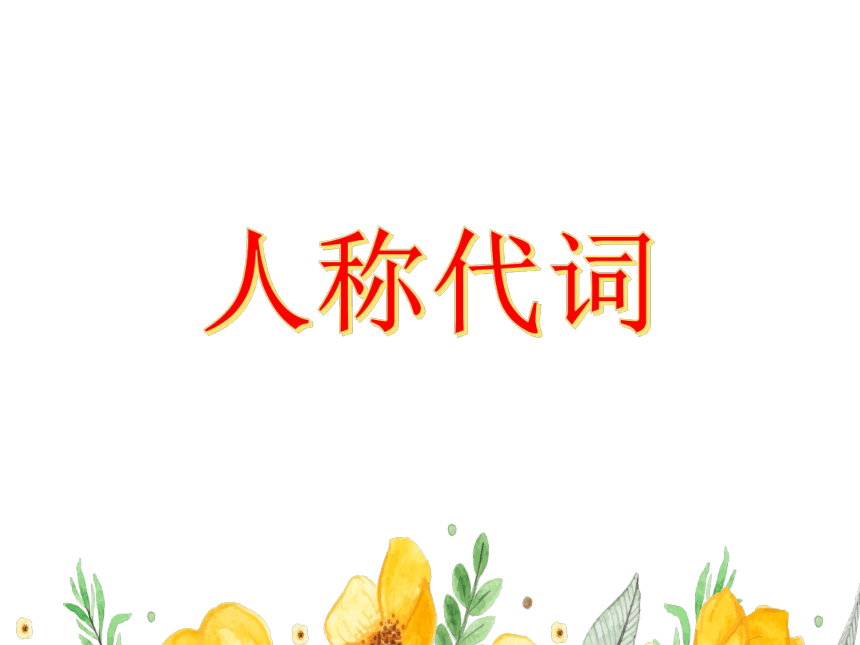
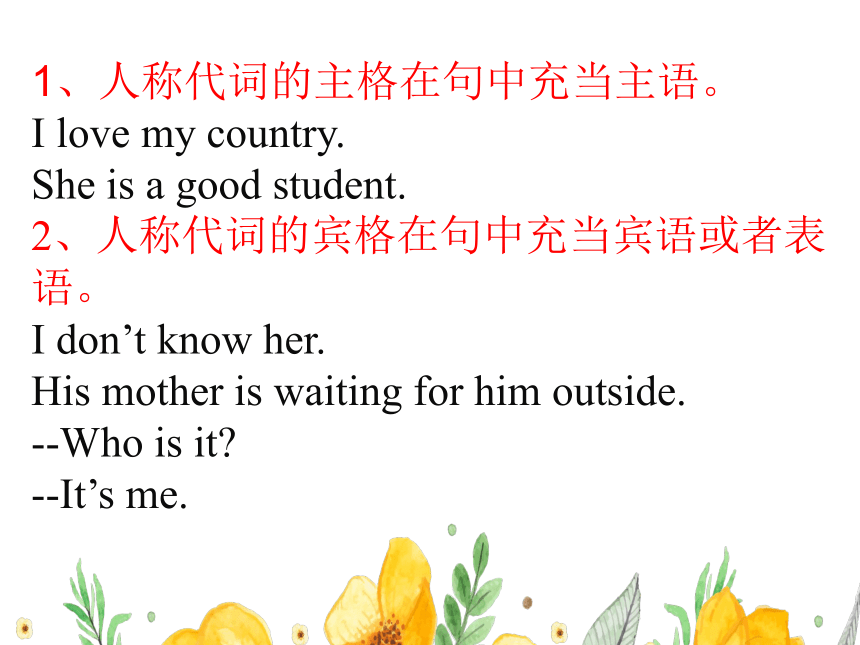
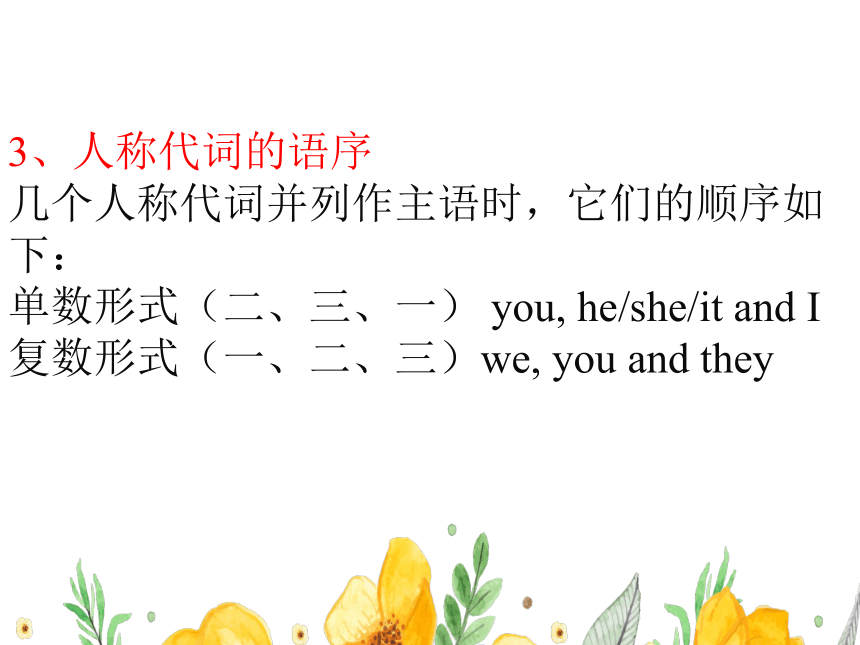
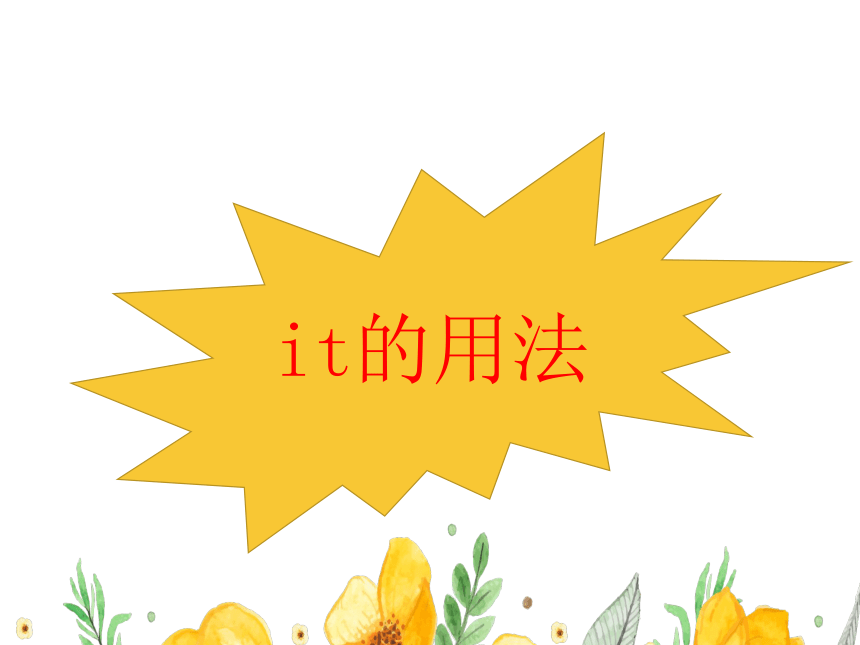
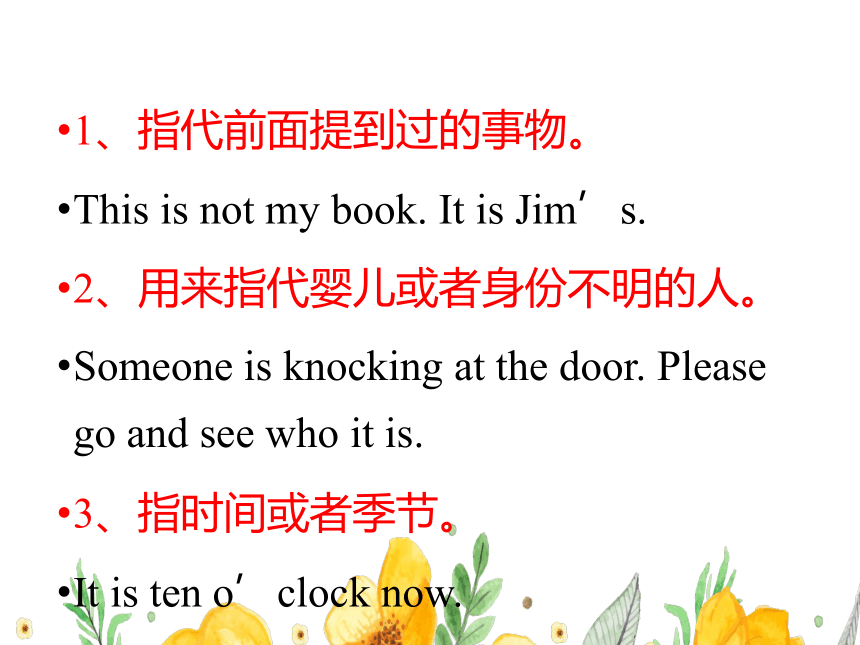
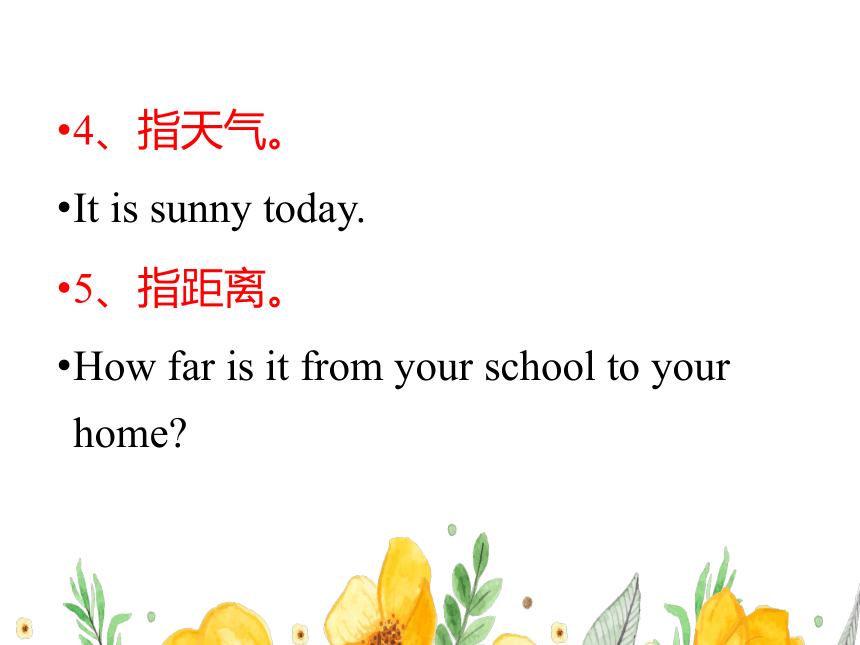
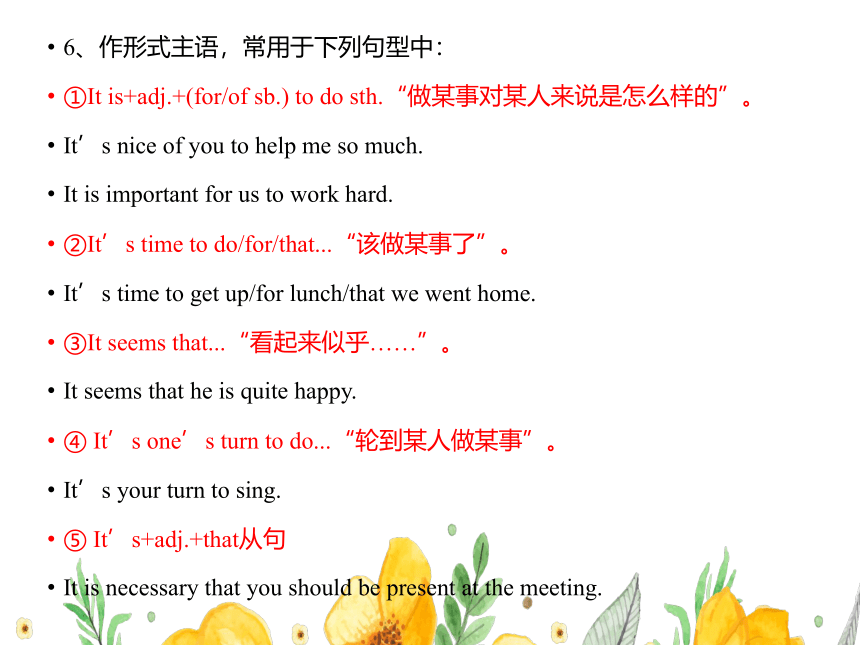
文档简介
(共26张PPT)
中考英语语法专题讲解——代词
物主代词
指示代词
反身代词
疑问代词
不定代词
1、人称代词的主格在句中充当主语。
I love my country.
She is a good student.
2、人称代词的宾格在句中充当宾语或者表语。
I don’t know her.
His mother is waiting for him outside.
--Who is it
--It’s me.
3、人称代词的语序
几个人称代词并列作主语时,它们的顺序如下:
单数形式(二、三、一) you, he/she/it and I
复数形式(一、二、三)we, you and they
it的用法
1、指代前面提到过的事物。
This is not my book. It is Jim’s.
2、用来指代婴儿或者身份不明的人。
Someone is knocking at the door. Please go and see who it is.
3、指时间或者季节。
It is ten o’clock now.
4、指天气。
It is sunny today.
5、指距离。
How far is it from your school to your home
6、作形式主语,常用于下列句型中:
①It is+adj.+(for/of sb.) to do sth.“做某事对某人来说是怎么样的”。
It’s nice of you to help me so much.
It is important for us to work hard.
②It’s time to do/for/that...“该做某事了”。
It’s time to get up/for lunch/that we went home.
③It seems that...“看起来似乎……”。
It seems that he is quite happy.
④ It’s one’s turn to do...“轮到某人做某事”。
It’s your turn to sing.
⑤ It’s+adj.+that从句
It is necessary that you should be present at the meeting.
7、作形式宾语。
形式宾语的常见结构为:think/feel/find+it+adj./n.+to do sth.
Do you think it necessary to learn to wait in line
1、形容词性物主代词放在名词前作定语,不能单独使用。
His parents are both office workers.
My name is Jack.
2、名词性物主代词常用来代替前面出现过的名词,相当于“形容词性物主代词+名词”。
This is my dictionary. Where is yours
My idea is different from hers.
1、反身代词用于动作发出者将动作反作用于本身,反身代词常用作宾语或者同位语。
The little boy is too young to look after himself.
I hope you can enjoy yourselves at the party.
The children made model planes themselves.
2、反身代词的常见词组
teach oneself 自学
learn by oneself 自学
enjoy oneself 玩得开心
help yourself to 随便吃
by oneself 独自
1、this/these指代距离较近的事物或者下文要提到的事物。
This is my pen.
These are my books.
Please remember this: No pains, no gains.
2、that/those指代距离较远的事物或者上文提到过的事物。
That’s her bike.
He was ill. That was why he didn’t go to school.
3、打电话时,用this介绍自己,that询问对方。
This is Mike speaking.
Who’s that
it特指上文提到的同一个事物,同类且同物;one泛指上文提及到的同类事物中的一个,同类而不同物;that常用于比较结构中,代替前面提到过的可数名词单数或者不可数名词,以避免重复,代替复数名词时用those。
The book is mine. It is very interesting.
--Who has a pen
--I have one.
The weather in Beijing is colder than that in Guangzhou in winter.
表示“一些”时,some和any既可以修饰可数名词也可以修饰不可数名词。some一般用于肯定句中,用于疑问句中表示说话人希望得到肯定的回答或表示请求和建议;any多用于疑问句、否定句和条件句中。
You will find some books in the box.
I need some stamps. Are there any in your bag
Would you like some rice for dinner
many与much
many指代可数名词复数;much指代不可数名词。
Many of us have seen the film.
I know much about it.
either与neither
either表示“两者中任何一个”;neither指两个人或物中任何一个都不。
I have two pens, but I don’t like either of them.
Neither of the books is good.
both, all与none
both表示“两者都”,all指三者或者三者以上都;none指三者或者三者以上都不,常用来回答how many/much引出的问题。
Both of my parents are farmers.
All of us should go there.
None of the students in our class can work out the maths problem.
--How much rice do you need
--None.
each与every
each是不定代词,在句中可以用作主语、宾语、表语、同位语或者定语,表示“每一个”;every是限定词,在句中用作定语。
Each of us wears a yellow T-shirt.
Every student has passed the exam.
(a) little与(a) few
a little(一点儿)和little(几乎没有)用来修饰不可数名词;a few(一些)和few(几乎没有)用来修饰可数名词。
Would you please buy some salt for me, Tony There is little left.
A few students are playing basketball on the playground.
the other, another, other, others, the others
不定代词 意义 用法说明
the other 两者中另一个 常与one连用,构成“one...the other...”;作定语修饰复数名词时,表示“其余的全部”。
another 三者或以上中另一个 指代三者或者以上中另一个。
other 另外的 只用作定语,常与复数名词连用,但如果前面有表示单数意义的限定词(this, that, any, one, my等),则与可数名词单数或者不可数名词连用。
others 泛指别的人或物 泛指别的人或物(但不是全部),不能作定语,相当于“other+复数名词”,常与some连用,构成“some...others...”。
the others 特指其余的人或物 特指其余所有的人或物,相当于“the other+名词复数”。
复合不定代词
复合不定代词为:somebody, someone, something, anybody, anyone, anything, nobody, nothing, everybody, everyone, everything。
Do you have anything special to tell me today
Listen to me, boys and girls. I have something to tell you.
中考英语语法专题讲解——代词
物主代词
指示代词
反身代词
疑问代词
不定代词
1、人称代词的主格在句中充当主语。
I love my country.
She is a good student.
2、人称代词的宾格在句中充当宾语或者表语。
I don’t know her.
His mother is waiting for him outside.
--Who is it
--It’s me.
3、人称代词的语序
几个人称代词并列作主语时,它们的顺序如下:
单数形式(二、三、一) you, he/she/it and I
复数形式(一、二、三)we, you and they
it的用法
1、指代前面提到过的事物。
This is not my book. It is Jim’s.
2、用来指代婴儿或者身份不明的人。
Someone is knocking at the door. Please go and see who it is.
3、指时间或者季节。
It is ten o’clock now.
4、指天气。
It is sunny today.
5、指距离。
How far is it from your school to your home
6、作形式主语,常用于下列句型中:
①It is+adj.+(for/of sb.) to do sth.“做某事对某人来说是怎么样的”。
It’s nice of you to help me so much.
It is important for us to work hard.
②It’s time to do/for/that...“该做某事了”。
It’s time to get up/for lunch/that we went home.
③It seems that...“看起来似乎……”。
It seems that he is quite happy.
④ It’s one’s turn to do...“轮到某人做某事”。
It’s your turn to sing.
⑤ It’s+adj.+that从句
It is necessary that you should be present at the meeting.
7、作形式宾语。
形式宾语的常见结构为:think/feel/find+it+adj./n.+to do sth.
Do you think it necessary to learn to wait in line
1、形容词性物主代词放在名词前作定语,不能单独使用。
His parents are both office workers.
My name is Jack.
2、名词性物主代词常用来代替前面出现过的名词,相当于“形容词性物主代词+名词”。
This is my dictionary. Where is yours
My idea is different from hers.
1、反身代词用于动作发出者将动作反作用于本身,反身代词常用作宾语或者同位语。
The little boy is too young to look after himself.
I hope you can enjoy yourselves at the party.
The children made model planes themselves.
2、反身代词的常见词组
teach oneself 自学
learn by oneself 自学
enjoy oneself 玩得开心
help yourself to 随便吃
by oneself 独自
1、this/these指代距离较近的事物或者下文要提到的事物。
This is my pen.
These are my books.
Please remember this: No pains, no gains.
2、that/those指代距离较远的事物或者上文提到过的事物。
That’s her bike.
He was ill. That was why he didn’t go to school.
3、打电话时,用this介绍自己,that询问对方。
This is Mike speaking.
Who’s that
it特指上文提到的同一个事物,同类且同物;one泛指上文提及到的同类事物中的一个,同类而不同物;that常用于比较结构中,代替前面提到过的可数名词单数或者不可数名词,以避免重复,代替复数名词时用those。
The book is mine. It is very interesting.
--Who has a pen
--I have one.
The weather in Beijing is colder than that in Guangzhou in winter.
表示“一些”时,some和any既可以修饰可数名词也可以修饰不可数名词。some一般用于肯定句中,用于疑问句中表示说话人希望得到肯定的回答或表示请求和建议;any多用于疑问句、否定句和条件句中。
You will find some books in the box.
I need some stamps. Are there any in your bag
Would you like some rice for dinner
many与much
many指代可数名词复数;much指代不可数名词。
Many of us have seen the film.
I know much about it.
either与neither
either表示“两者中任何一个”;neither指两个人或物中任何一个都不。
I have two pens, but I don’t like either of them.
Neither of the books is good.
both, all与none
both表示“两者都”,all指三者或者三者以上都;none指三者或者三者以上都不,常用来回答how many/much引出的问题。
Both of my parents are farmers.
All of us should go there.
None of the students in our class can work out the maths problem.
--How much rice do you need
--None.
each与every
each是不定代词,在句中可以用作主语、宾语、表语、同位语或者定语,表示“每一个”;every是限定词,在句中用作定语。
Each of us wears a yellow T-shirt.
Every student has passed the exam.
(a) little与(a) few
a little(一点儿)和little(几乎没有)用来修饰不可数名词;a few(一些)和few(几乎没有)用来修饰可数名词。
Would you please buy some salt for me, Tony There is little left.
A few students are playing basketball on the playground.
the other, another, other, others, the others
不定代词 意义 用法说明
the other 两者中另一个 常与one连用,构成“one...the other...”;作定语修饰复数名词时,表示“其余的全部”。
another 三者或以上中另一个 指代三者或者以上中另一个。
other 另外的 只用作定语,常与复数名词连用,但如果前面有表示单数意义的限定词(this, that, any, one, my等),则与可数名词单数或者不可数名词连用。
others 泛指别的人或物 泛指别的人或物(但不是全部),不能作定语,相当于“other+复数名词”,常与some连用,构成“some...others...”。
the others 特指其余的人或物 特指其余所有的人或物,相当于“the other+名词复数”。
复合不定代词
复合不定代词为:somebody, someone, something, anybody, anyone, anything, nobody, nothing, everybody, everyone, everything。
Do you have anything special to tell me today
Listen to me, boys and girls. I have something to tell you.
同课章节目录
- 词法
- 名词
- 动词和动词短语
- 动词语态
- 动词时态
- 助动词和情态动词
- 非谓语动词
- 冠词
- 代词
- 数词和量词
- 形容词副词及其比较等级
- 介词和介词短语
- 连词和感叹词
- 构词法
- 相似、相近词比较
- 句法
- 陈述句
- 一般疑问句和否定疑问句
- 特殊疑问句及选择疑问句
- 反意疑问句
- 存在句(There be句型)
- 宾语从句
- 定语从句
- 状语从句
- 主谓一致问题
- 简单句
- 并列句
- 复合句
- 主谓一致
- 主、表语从句
- 名词性从句
- 直接引语和间接引语
- 虚拟语气
- 感叹句
- 强调句
- 倒装句
- 祈使句
- 句子的成分
- 句子的分类
- 题型专区
- 单项选择部分
- 易错题
- 完形填空
- 阅读理解
- 词汇练习
- 听说训练
- 句型转换
- 补全对话
- 短文改错
- 翻译
- 书面表达
- 任务型阅读
- 语法填空
- 其他资料
